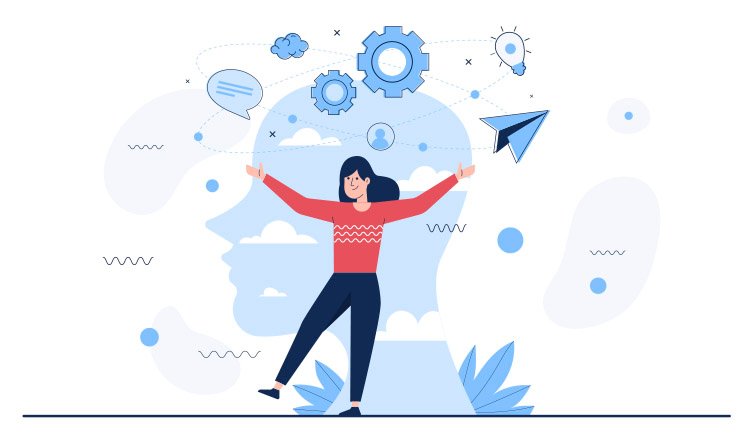What is NLP Modeling and Why It Can Accelerate Your Personal Transformation

|
Getting your Trinity Audio player ready...
|
Have you ever wondered why some people seem to achieve extraordinary results in such a short time, while others spend years floundering? Is there a hidden secret or a magic formula? Neuro-Linguistic Programming (NLP) answers this question with a simple yet powerful concept: modeling.
Modeling is one of the core tools of NLP. It's based on the idea that if someone achieves excellence in a given area, it's possible to observe, understand, and replicate their patterns of thought, behavior, and emotion. In other words, there's no need to reinvent the wheel: just learn from those who have already walked the path.
In this article, we'll dive deep into NLP modeling, understanding its origins, how to apply it in practice, and why it can accelerate your personal transformation. Get ready, because this journey could completely change the way you view learning and growth.
What is modeling in NLP?
THE modeling in NLP emerged in the 1970s, when Richard Bandler and John Grinder, the creators of NLP, began studying successful therapists and communicators. They observed hidden patterns that explained why some professionals achieved extraordinary results.
Simply put, modeling is the process of identifying how a person does what they do—and then replicating that pattern. This includes not only their visible actions, but also their thoughts, beliefs, and emotional states.
“NLP modeling is the method of learning from other people's excellence and adapting those patterns to your life.”
In fact, modeling is something we've been doing since childhood. In this sense, when we learn to speak, walk, or even brush our teeth, we imitate those who already know how. The difference is that, in NLP, this practice is done in a conscious, strategic and targeted way to achieve specific objectives.
Why Modeling Is So Powerful in Neuro-Linguistic Programming
“If someone can, you can too”
One of the basic assumptions of NLP states: “If one person can do something, anyone can learn to do it, as long as they discover how he does it.” This is the essence of modeling.
So, instead of clinging to the limiting belief that “I can’t do it,” you start asking yourself: “How did that person do it?” and “What can I replicate in my context?”
The Science Behind Imitation and Mirror Neurons
Neuroscience also reinforces this process. After all, research shows the relationship with so-called mirror neurons, responsible for our learning through observation. Thus, when we see someone perform an action, the brain activates the same areas as if we were doing the same thing ourselves. This is why watching an athlete or listening to a great speaker can inspire us so much, because our brain is already rehearsing internally.
Modeling inspirations in NLP
Michael Jordan, Serena Williams, and Ayrton Senna have something in common: mental discipline. Modeling athletes means observing not only their physical training, but also how they handle pressure, motivation, and focus.
Similarly, figures like Steve Jobs, Oprah Winfrey, and Bill Gates demonstrate leaders who defied standards. Modeling these profiles allows us to learn how they think, how they make decisions, and how they face seemingly impossible challenges.
On the other hand, we don't always need globally recognized icons. Often, modeling a colleague who successfully overcame procrastination or a friend who rebuilt their life after a failure can provide equally valuable insights.
How to apply modeling in your life
Mindful observation: seeing beyond the surface
Modeling isn't simply copying a routine or imitating gestures. In this way, it's like watching a movie in slow motion, looking for details that would normally go unnoticed. When observing someone, go beyond what meets the eye. Ask yourself: “What does this person think when faced with a challenge?” or “"What internal dialogue She probably holds on to stay motivated?”.
For example, an athlete who remains calm in decisive moments isn't just taking deep breaths; they've likely trained their mind to associate pressure situations with states of concentration, not panic. Conscious observation involves analyzing body language, the way a person talks to themselves, and even how they react to failure. It's this "invisible" that makes all the difference in modeling.
Reproduce mental, emotional and behavioral patterns
After observing comes the experimentation phase. This is where many people get confused: it's not enough to simply repeat gestures or phrases; you need to enter the mental and emotional state that supports the action.
So, imagine someone you admire for their public speaking skills. You might even imitate their posture and tone of voice, but if you don't internally cultivate the confidence they feel, the results will be superficial. Therefore, in NLP modeling, you seek to understand the "internal software": beliefs, intentions, and emotions.
In practice, this means practicing not only external actions but also putting yourself in the same emotional state. If the model accesses courage before acting, you can create your own. anchor to activate this state before facing challenging situations.
Adapt modeling to your context
However, one of the biggest misconceptions is that modeling someone means becoming a carbon copy. Quite the opposite. The truth is that each person has their own unique history, environment, and resources. What works for a Silicon Valley entrepreneur may need adjustments for a Brazilian entrepreneur starting out with little capital.
Adapting means translating standards of excellence into your reality. Ask yourself: “How can I apply this strategy within my time, energy, and resource constraints?”.
For example, if you model the discipline of a writer who writes 5 hours a day, but your routine only allows for 1 hour, that doesn't mean failure. It means you're adapting the strategy to your context—and still bringing consistency to your life.
“Modeling is not imitation. It's inspiration transformed into practical, personalized action.”
Be careful of what might hinder your practice
Unrealistic expectations
One of the biggest pitfalls for those who begin applying modeling is believing that results will appear overnight. In other words, it's like planting a seed today and expecting to reap the rewards tomorrow. Everyone has different timeframes, backgrounds, and resources. What you observe in a successful athlete or entrepreneur may have taken years of training, mistakes, and adjustments.
That is, modeling accelerates learning, but it doesn't eliminate the process. The key is to be clear that you're shortening the path, but not taking a magical shortcut. In other words, you must adjust your expectations to avoid frustration, understanding that each step is already part of the transformation.
Inadequate choice of models
Another obstacle is choosing role models that aren't aligned with the outcome you desire. For example, there's no point modeling someone who appears financially successful but lives in emotional imbalance if your goal is to build prosperity with a high quality of life.
Therefore, a good role model should inspire on several levels: behaviors, beliefs, values, and lifestyle. It's important to analyze the whole picture, not just the final result. Ask yourself: “Does this person have a life I would like to live?” If the answer is no, it may not be the ideal model for you.
Copy without adapting to your individuality
A classic mistake is trying to become a replica of your role model. This is not only impossible but also disrespectful to your own essence. Remember: NLP works with the idea that each person has their own unique and non-transferable "world map."
Therefore, if you copy without adapting, you risk losing your authenticity and ending up frustrated. Modeling doesn't require you to transform into someone else, but rather to extract patterns of excellence and translate them into your own style. It's like using a cake recipe: the ingredients are the same, but the final flavor depends on your touch, your kitchen, and even your oven.
“Modeling yields results when it respects your individuality and the natural timing of the process.”
Practical modeling exercise in 5 steps
Modeling isn't an instant trick; it's a process of conscious practice. Therefore, the following exercise goes beyond simply copying. It requires observation, reflection, and constant practice.
Step 1 – Choosing the right model
Clearly define what you want to develop. For example, it could be confidence in public speaking, discipline in studying, or focus on completing projects. Only after defining this should you choose someone who represents this quality. It doesn't have to be famous: it could be a coworker or even a family member.
Step 2 – Close and deep observation
Next, take on the role of investigator. Above all, observe not only what the person does, but how they do it. How do they behave under pressure? How do they handle mistakes? What words do they use when they talk about themselves? In NLP, we call this calibration: looking beyond the surface, capturing details of posture, breathing, tone of voice, and even facial microexpressions.
Step 3 – Identifying beliefs and values
Ask yourself: “What does this person believe to sustain this behavior?” and “What values seem to guide your choices?”Often, the difference between success and stagnation lies at this invisible level. If an athlete believes that every defeat is a learning experience, it completely changes their resilience.
Step 4 – Reproduce internal states and behaviors
Now it's time to experiment. So, put yourself in the other person's shoes and ask: “If I thought and felt like her, how would I act now?”You can practice postures, internal phrases, and even imagine situations in which your model would succeed. This practice helps build neural connections and expand your response options.
Step 5 – Adaptation and consistent practice
This is the key point: it's not enough to replicate something once. Above all, you need to adapt it to your context and repeat it until it becomes natural. So, note what works, adjust what doesn't, and celebrate small victories. Modeling is a living process: the more you practice, the more it adapts to your identity.
“Modeling works when you observe deeply, internally recreate states of excellence, and consistently adapt them to your own lifestyle.”
How NLP Modeling Accelerates Your Personal Transformation
Overcoming limiting beliefs: When you realize that someone similar to you has managed to get there, it automatically weakens the belief that it is impossible.
Creating habits more easily: Instead of fighting old patterns alone, you use shortcuts already tested by others.
Reprogramming your mindset for the future: Modeling is essentially training your brain to think, feel, and act differently. Primarily, it's one of the fastest ways to mentally reprogram and build a life more aligned with your goals.
Conclusion: The Power to Choose Who You Want to Become
NLP modeling shows that we don't need to live stuck in old patterns. Quite the opposite. We can consciously choose who we want to model and, from there, create more powerful versions of ourselves. However, it's not about copying, but about learning from the best and transforming that learning into something unique.
So, in the end, the question is: Who will you choose to model to accelerate your own transformation?
FAQ – Questions and Answers about Modeling in NLP
1. What does modeling mean in NLP?
Modeling is observing and replicating patterns of thought, emotion, and behavior of people who have already achieved excellence, adapting them to your life.
2. Do I need to copy everything from my template?
No. The idea is to adapt the standards while respecting their individuality. Copying without adapting can lead to frustration.
3. Does modeling only work with famous people?
No. You can model colleagues, friends, or even family members who have achieved something you admire.
4. How long does it take for modeling to bring results?
It depends on how much you practice and adapt. Some results may come quickly, while others require consistency.
5. Is modeling the same thing as imitation?
No. Imitating is superficial reproduction. Modeling is understanding the internal structure behind the results and applying them consciously.
Image: Freepik

Marcel Castilho is an expert in neuromarketing, neuroscience, mindfulness and positive psychology. In addition to being an advertiser, he also has a Master's degree in NLP – Neurolinguistic Programming. As the owner and founder of the communications agency VeroCom and also of the digital agency Vero Contents, he has been studying human behavior for over 30 years.

